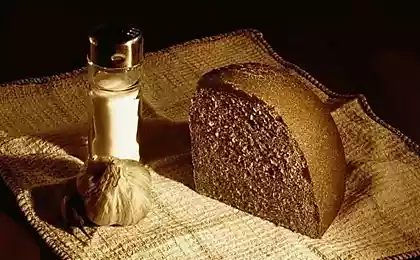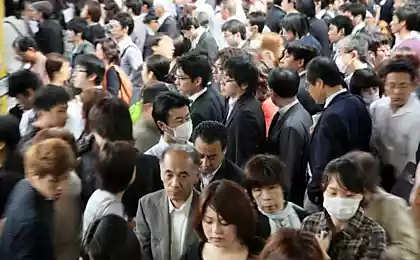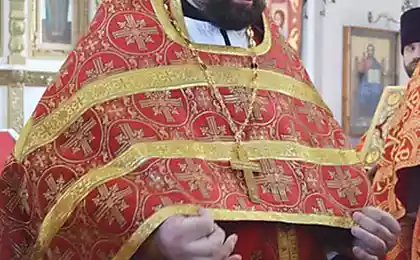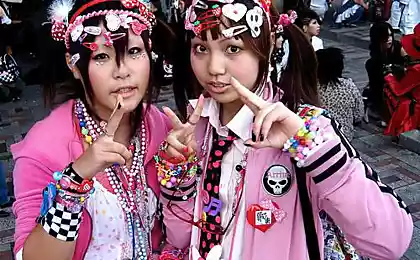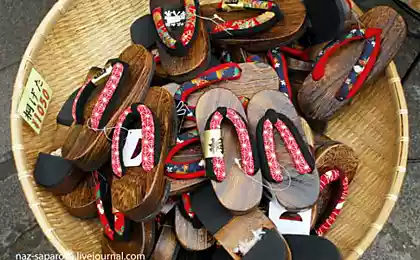1243
This post is dedicated solely odzumo - "large" or professional sumo in Japan
This post is dedicated solely odzumo - "large" or professional sumo in Japan
I hasten to note that the Japanese are of great importance of the concept of honor and dignity, so it is no wonder their commitment to strict adherence to rituals and ceremonies, in their eyes, it strengthens the connection times and solidarity of all of Japanese society
National Japanese sumo wrestling has a very ancient history, some researchers estimate it in 2000 years. The first mention in chronicles in 642
In the 12th century there was a division in the sumo fighting, sports and religious. In the 13-14 centuries were regular sport sumo tournaments. Sumo heyday came in the 17th century (Edo era), but then formed and the basic rules of combat, from there originate all the rituals and canons of sumo. Until the 60s of the 20th century foreigners in sumo is not allowed, then this restriction was removed in the late 80's sumo moved Hawaiians (konishiki, Akebono), and in the late '90s - in the 2000s came the Mongols (Asashoryu, Hakuho, ozeki many)
All matches take place in the sumo dohyo - square earthen platform height of 40-60 cm with a side of 7 to 27 m, the center of the square is a circle diameter of 4, 55 m, laid Tawara - thick plait of rice straw. In the center at a distance of 60 cm 2 marked white lines marking the starting positions of fighters, these items are always positioned on the line of "East-West". This circle is the arena for the match. Circle inside and 25-30 cm for Tawara sprinkled with coarse sand, the band of Tawara is aligned to determine the winner of the match (if needed). The sloping walls made 8 steps, sumo wrestler, and to judge gёdzi could climb Doha, Doha is located on the canopy-yakata, before he relied on the corner posts, is now suspended on cables above it is always the flag of Japan. Skip to Doha hanamiti called - "the way of flowers". Doha is made within 72 hours before the match of 15-17 tons of clay, specially brought from hiding places known only to some initiated, in the manufacturing process in Doha buried sacred talismans - shrimp, seaweed, Chinese plum, sacred salt (a symbol of purification) then okraplyayutsya sanctified sake - and Doha considered free from evil spirits and ready to receive fighters. Note finally that Doha is a sacred place for the ancient tradition of women it is not allowed
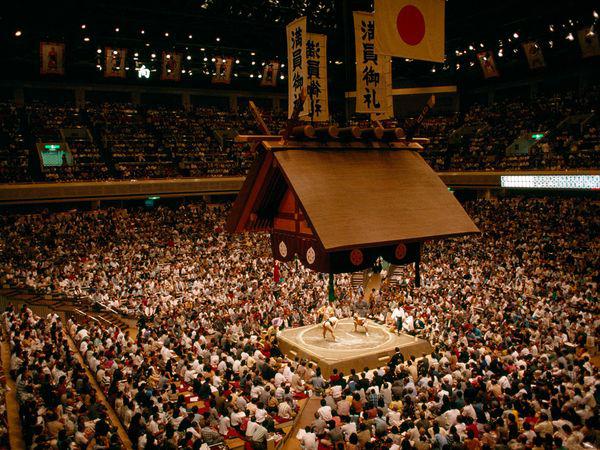
Currently, bandzuke - official rankings Japan Sumo Association - are 700 sumo wrestler, their titles repaired strict hierarchy
Conditionally all odzumo divided into "east" and "west", but really - 6 leagues, from the older to the younger makuuti (40 wrestlers), dzyurё (28 wrestlers), makushita, sandanme, dzenidan, dzenokuti, the first two are considered to be professional, they are called sekitori wrestlers, the rest are Student
The Majors makuuti fighters assigned official titles
The highest - yokozuna "grand champion" is awarded by a special commission for life, but if yokozuna shows deterioration of results - he has volunteered to complete the journey. Now one yokozuna - Hakuho
They are followed by the title of the Sagnac it ozeki - "champion", now there are four (Baruto, Kotooshu, Haromafudzi and Cayo), then sekivake, komosubi maegasira and ordinary, they are simply numbered, eg 10th maegasira East
In the lower leagues all fighters are numbered, eg 4th sandanme West
Outfit sumo wrestler does not differ splendor - dressing-mawashi, consisting of wrapped around the body of 4 to 8 times a silk band width of 40-60 cm under her belt attached ceremonial arrows, and samurai pigtail-MAGE, it is believed that it protects the head in the sumo wrestler falls backward. In the rank and file fighters is simply a broken bundle of hair from sakitori he is more pretentiousness
The basic unit is odzumo Haye, "room" (currently 53), a training house, where all the wrestlers live - exercise, sleep, eat chanko, specially prepared by a special high-calorie food recipes, and rice
The daily routine is severe sumo wrestler - rise at 5 am, exercise, breakfast, practice, "quiet time", lunch and training before dark. Dinner they have
Refuel all in Hay oyakata, "teacher" who oversees the preparation of the wrestlers, their regime, the results of its all obey unquestioningly
Haye called by the name of oyakata, considered the most influential Futagoyama, but it tightened Musasigava and Sadogatake
Begin to engage in sumo is usually 15 years, to take Haye from 18 years wrestler to walk on the path rikishi should not be less than 173 cm in height and weighing less than 75 kg
The life of a rookie in Hay heavy and full of humiliation, they are beaten and forced to perform humiliating assignments chase for every little thing that is believed to be in the sumo wrestler brings resilience and fighting spirit. In addition, lower-ranking subservient highest not only in the Haye, but in a tournament-Basho
The conventional wisdom that all sumo wrestler - obese giants - is wrong in principle, the average weight is 150 kg sakitori with significant muscle mass, what is easy to see by looking at the photo, but there are extremes
Weight konishiki (pictured in the header) in different periods was 270-310 kg, and the weight was Maynoumi less than 95 kg, which did not prevent both of them show good results
Life sumo wrestler - it's not just the endless training and competition, but also the many rituals that must be precisely and accurately perform know
The most colorful - This goes out to Doha
First - the dohyo-iri, the yield on the Doha sakitori. This is done in kesё-mawashi, mawashi special holiday, made of silk and embroidered with silver and gold threads. The cost of such "aprons" of 400-500 thousand yen (3.5-5 thousand dollars)
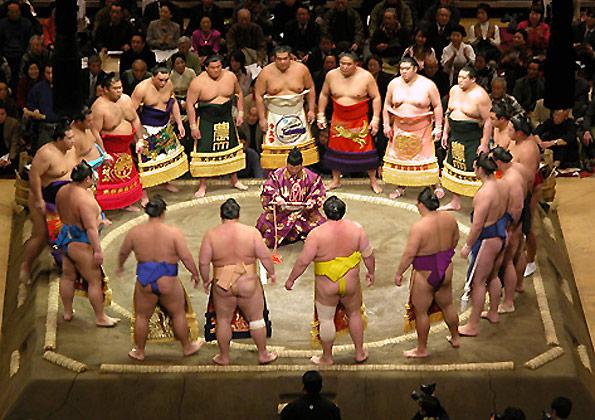
Then follows the yokozuna dohyo-iri-yield "a great champion." In addition kesё-mawashi, he puts on shimenawa, special belt bleached rice straw rope reminiscent of variable thickness. As you can see, in order to properly tie it requires the efforts of six (!) Sumo wrestler

Then he probably just cut off, maybe a new yokozuna basho must manufacture new, what he is issued a special amount of money
This is followed by itself tsereioniya, during which you and the famous Sicko, powerful blows on the soles of Doha, aimed to expel evil spirits
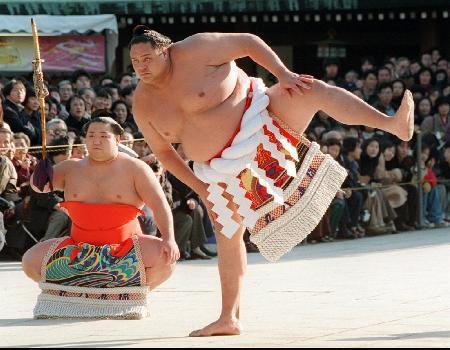
Yokozuna comes accompanied by two squires, one of which bears his ritual sword
Also, a ceremony exit judges gёdzi, sledyashih the progress of the match on the dohyo. They dress in a kimono Kamakura period (14-15 centuries), they also have a hierarchy, in particular, matches involving yokozuna can only judge tate-gёdzi judge of the highest rank. Beyond Doha follow the progress of the fight simpany, led by the doyen of five, in the case of a controversial decision by referee convened sovet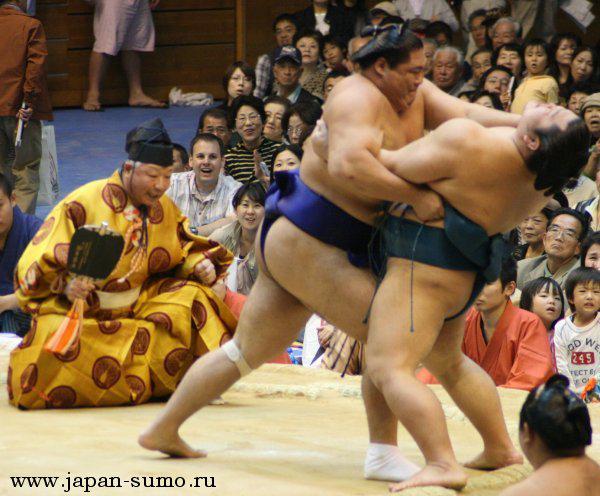
Basho Tournaments are now held six times a year (up to 60-ies there were only 2), in odd months
January (Tokyo) - Hatsu-basho in March (Osaka), May (Tokyo) - Natsu Basho-July (Nagoya), September (Tokyo) - Aki Basho is now talking and November (Fukuoka). Basho always starts and ends on Sunday, lasts 15 days, sakitori spend 15 fights, one each day, the other sumo wrestler - to 7. For the victory is given to the white ball, black for the defeat. Fighters usually meet with their peers on forces rivals yokozuna must meet all the yokozuna in the tournament (there may be up to 5) and all subordinate sakitori. Meetings of representatives of a Haye are not allowed, with the exception of ketteysen, super final in the event of an equality of white balls. Densё - 15 white balls, absolute result, katsikosi - the superiority of white balls, makekosi - the superiority of the black balls. In case of unsatisfactory results sakitori can be put in kodoban, a position in which he must record the following Basho katsikosi, otherwise it will be demoted in rank
Actually the match starts with the ceremony sikiri when opponents take ritual poses drill each other's eyes, beat himself on the chest and shoulders (this is especially famous Takamisakari- "Robocop"), in general, are psychological treatment opponent while sakitori throw at Doha ritual purifying salt. After sikiri wrestlers are required to take the posture of attack, focusing on his fists, and only then can begin to start rapprochement tatiay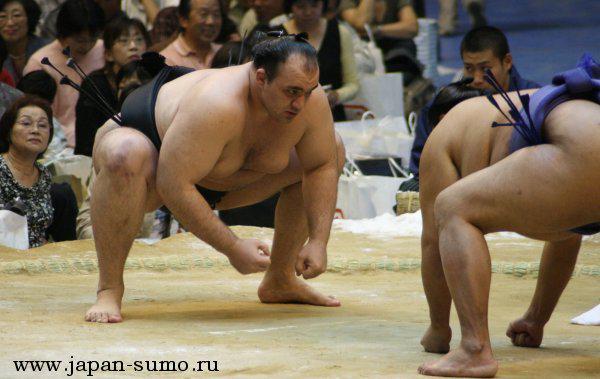
However, some sumo wrestler used tatiayhenka, dummy, when the contestant goes away from the opponent and without the support falls on Doha, this technique does not honor sumo wrestler, and his use of yokozuna is a sharp public outcry. After convergence wrestlers can enter the clamp-nage, used slap-tsupari, do choke the open palm of nodes, there are many acceptable methods. Unacceptable injections eye jerks ears and nose, punching and kicking, capture MAGE, intentional ripping mawashi (although if mawashi untied the fault of the sumo wrestler - he loses, and this was the case). There are 2 test defeat - if the wrestler touched the dohyo inside the circle with any part of the body other than his feet or when he touched the dohyo outside tavara
The climax of the fight is kimarite concluding the technical action. A total of 82, the most common - ёrikiri "embossing force" when the wrestler grabs the opponent's mawashi behind and pushes his body jerks, this reception won a third of all battles. There are also kakedzori - shot through the thigh osidasi - pushing an opponent, hikiotosi - jerk opponents down or seizure of arms plecha
and finally, the most spectacular and rare - ippondzoy, throw yourself through the capture of the enemy with his own hands his hands in the recent history of sumo, he succeeded only Caio (170 kg) in the fight against musashimaru (220 kg)
More about kimarite here
At the end of the fight sumo wrestler waiting for solutions gёdzi, after the announcement of which make a diagonal slashing gesture palm of his right hand and can go to Doha, if they are not due kimarite! Kimarite - it envelopes with money for the fight prizora in each envelope for 3,000 yen (about $ 300), the number of envelopes depends on the generosity of sponsors and interest in the fight. Kensho brings gёdzi winner on his bamboo fan, a winner makes a thanksgiving gesture - as if chopping right hand edge of the left-right-middle and then can take kensho
Sitemy payments and rewards to odzumo rich and diverse
So, the winner of the league gets makuuti:
Imperial Cup - presents a member of the ruling dynasty (at the January tournament, where more and handed the cup of the Prime Minister, this tournament is very respected sumo wrestler) or a high rank in the Japan Sumo Association
10 million yen prize
news: new car, a year's supply of gasoline, the annual supply of food, all kinds of values, just accumulates about 30 million yen (why were so upset sakitori after learning of the decision of the Association to abandon the gifts in connection with the scandal associated with baseball betting, this summer)
In dzyurё winner gets 2 million yen prize money, in other leagues reward more modest
In addition, to the rank of sumo wrestler komosubi and below are special prizes (2 million yen):
syukunsё - for defeating yokozuna or ozeki (imputed "gold star»)
kantosё - for showing fighting spirit throughout the tournament
ginosё - for technical skills
Read more about the award viewed in Vick
But above all, famous for its odzumo rikishi
Throughout the more than 300-year history of sumo rank of yokozuna awarded only 69
Especially famous Tycho, many consider him the greatest yokozuna in history, by the way, his Ukrainian roots
Who pushed Hakuho, he has repeated the record in Tienofudzi 53 wins in a row, and after the resignation Asashoryu, seriously sights on record Futabayama 69 wins, set back in the years 1936-39, when carried out by two more basho a year
More about yokozuna here
In conclusion, a few photos of prominent rikishi
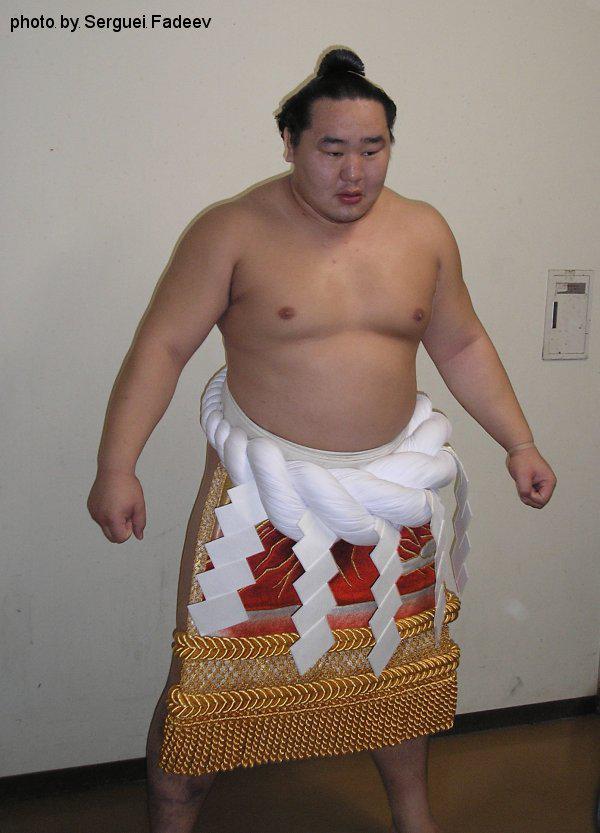
Yokozuna Asashoryu
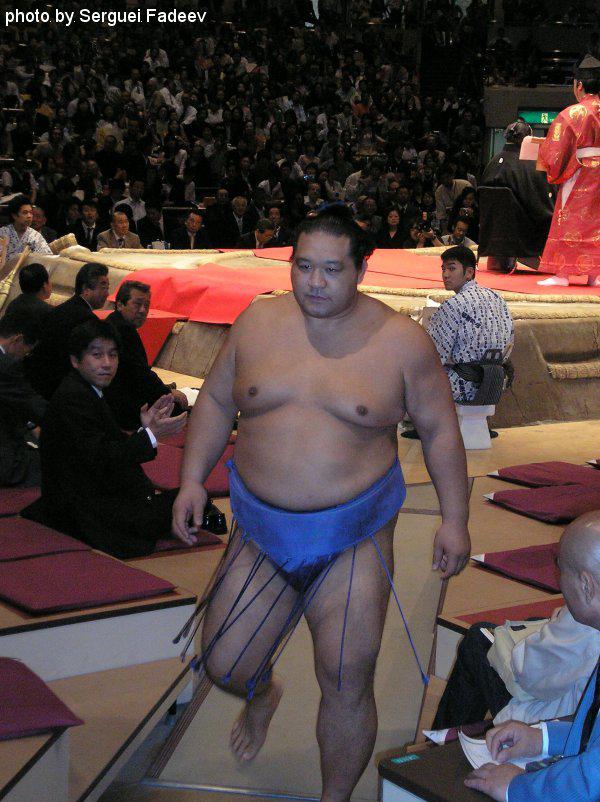
Ozeki Cayo

Takamisakari
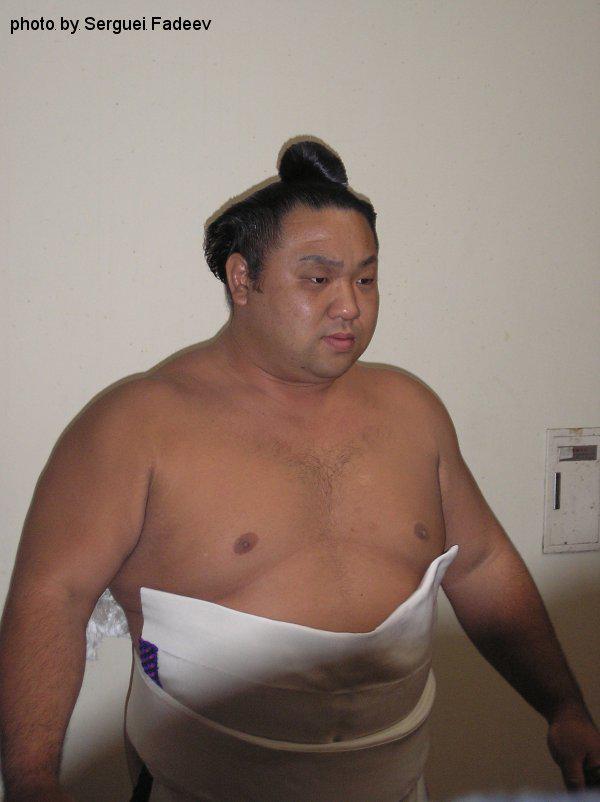
Tiёtaykay
The path ends rikishi ostriganiem spit MAGE, after which the hair with it to be of value
I hasten to note that the Japanese are of great importance of the concept of honor and dignity, so it is no wonder their commitment to strict adherence to rituals and ceremonies, in their eyes, it strengthens the connection times and solidarity of all of Japanese society
National Japanese sumo wrestling has a very ancient history, some researchers estimate it in 2000 years. The first mention in chronicles in 642
In the 12th century there was a division in the sumo fighting, sports and religious. In the 13-14 centuries were regular sport sumo tournaments. Sumo heyday came in the 17th century (Edo era), but then formed and the basic rules of combat, from there originate all the rituals and canons of sumo. Until the 60s of the 20th century foreigners in sumo is not allowed, then this restriction was removed in the late 80's sumo moved Hawaiians (konishiki, Akebono), and in the late '90s - in the 2000s came the Mongols (Asashoryu, Hakuho, ozeki many)
All matches take place in the sumo dohyo - square earthen platform height of 40-60 cm with a side of 7 to 27 m, the center of the square is a circle diameter of 4, 55 m, laid Tawara - thick plait of rice straw. In the center at a distance of 60 cm 2 marked white lines marking the starting positions of fighters, these items are always positioned on the line of "East-West". This circle is the arena for the match. Circle inside and 25-30 cm for Tawara sprinkled with coarse sand, the band of Tawara is aligned to determine the winner of the match (if needed). The sloping walls made 8 steps, sumo wrestler, and to judge gёdzi could climb Doha, Doha is located on the canopy-yakata, before he relied on the corner posts, is now suspended on cables above it is always the flag of Japan. Skip to Doha hanamiti called - "the way of flowers". Doha is made within 72 hours before the match of 15-17 tons of clay, specially brought from hiding places known only to some initiated, in the manufacturing process in Doha buried sacred talismans - shrimp, seaweed, Chinese plum, sacred salt (a symbol of purification) then okraplyayutsya sanctified sake - and Doha considered free from evil spirits and ready to receive fighters. Note finally that Doha is a sacred place for the ancient tradition of women it is not allowed

Currently, bandzuke - official rankings Japan Sumo Association - are 700 sumo wrestler, their titles repaired strict hierarchy
Conditionally all odzumo divided into "east" and "west", but really - 6 leagues, from the older to the younger makuuti (40 wrestlers), dzyurё (28 wrestlers), makushita, sandanme, dzenidan, dzenokuti, the first two are considered to be professional, they are called sekitori wrestlers, the rest are Student
The Majors makuuti fighters assigned official titles
The highest - yokozuna "grand champion" is awarded by a special commission for life, but if yokozuna shows deterioration of results - he has volunteered to complete the journey. Now one yokozuna - Hakuho
They are followed by the title of the Sagnac it ozeki - "champion", now there are four (Baruto, Kotooshu, Haromafudzi and Cayo), then sekivake, komosubi maegasira and ordinary, they are simply numbered, eg 10th maegasira East
In the lower leagues all fighters are numbered, eg 4th sandanme West
Outfit sumo wrestler does not differ splendor - dressing-mawashi, consisting of wrapped around the body of 4 to 8 times a silk band width of 40-60 cm under her belt attached ceremonial arrows, and samurai pigtail-MAGE, it is believed that it protects the head in the sumo wrestler falls backward. In the rank and file fighters is simply a broken bundle of hair from sakitori he is more pretentiousness
The basic unit is odzumo Haye, "room" (currently 53), a training house, where all the wrestlers live - exercise, sleep, eat chanko, specially prepared by a special high-calorie food recipes, and rice
The daily routine is severe sumo wrestler - rise at 5 am, exercise, breakfast, practice, "quiet time", lunch and training before dark. Dinner they have
Refuel all in Hay oyakata, "teacher" who oversees the preparation of the wrestlers, their regime, the results of its all obey unquestioningly
Haye called by the name of oyakata, considered the most influential Futagoyama, but it tightened Musasigava and Sadogatake
Begin to engage in sumo is usually 15 years, to take Haye from 18 years wrestler to walk on the path rikishi should not be less than 173 cm in height and weighing less than 75 kg
The life of a rookie in Hay heavy and full of humiliation, they are beaten and forced to perform humiliating assignments chase for every little thing that is believed to be in the sumo wrestler brings resilience and fighting spirit. In addition, lower-ranking subservient highest not only in the Haye, but in a tournament-Basho
The conventional wisdom that all sumo wrestler - obese giants - is wrong in principle, the average weight is 150 kg sakitori with significant muscle mass, what is easy to see by looking at the photo, but there are extremes
Weight konishiki (pictured in the header) in different periods was 270-310 kg, and the weight was Maynoumi less than 95 kg, which did not prevent both of them show good results
Life sumo wrestler - it's not just the endless training and competition, but also the many rituals that must be precisely and accurately perform know
The most colorful - This goes out to Doha
First - the dohyo-iri, the yield on the Doha sakitori. This is done in kesё-mawashi, mawashi special holiday, made of silk and embroidered with silver and gold threads. The cost of such "aprons" of 400-500 thousand yen (3.5-5 thousand dollars)

Then follows the yokozuna dohyo-iri-yield "a great champion." In addition kesё-mawashi, he puts on shimenawa, special belt bleached rice straw rope reminiscent of variable thickness. As you can see, in order to properly tie it requires the efforts of six (!) Sumo wrestler

Then he probably just cut off, maybe a new yokozuna basho must manufacture new, what he is issued a special amount of money
This is followed by itself tsereioniya, during which you and the famous Sicko, powerful blows on the soles of Doha, aimed to expel evil spirits

Yokozuna comes accompanied by two squires, one of which bears his ritual sword
Also, a ceremony exit judges gёdzi, sledyashih the progress of the match on the dohyo. They dress in a kimono Kamakura period (14-15 centuries), they also have a hierarchy, in particular, matches involving yokozuna can only judge tate-gёdzi judge of the highest rank. Beyond Doha follow the progress of the fight simpany, led by the doyen of five, in the case of a controversial decision by referee convened sovet

Basho Tournaments are now held six times a year (up to 60-ies there were only 2), in odd months
January (Tokyo) - Hatsu-basho in March (Osaka), May (Tokyo) - Natsu Basho-July (Nagoya), September (Tokyo) - Aki Basho is now talking and November (Fukuoka). Basho always starts and ends on Sunday, lasts 15 days, sakitori spend 15 fights, one each day, the other sumo wrestler - to 7. For the victory is given to the white ball, black for the defeat. Fighters usually meet with their peers on forces rivals yokozuna must meet all the yokozuna in the tournament (there may be up to 5) and all subordinate sakitori. Meetings of representatives of a Haye are not allowed, with the exception of ketteysen, super final in the event of an equality of white balls. Densё - 15 white balls, absolute result, katsikosi - the superiority of white balls, makekosi - the superiority of the black balls. In case of unsatisfactory results sakitori can be put in kodoban, a position in which he must record the following Basho katsikosi, otherwise it will be demoted in rank
Actually the match starts with the ceremony sikiri when opponents take ritual poses drill each other's eyes, beat himself on the chest and shoulders (this is especially famous Takamisakari- "Robocop"), in general, are psychological treatment opponent while sakitori throw at Doha ritual purifying salt. After sikiri wrestlers are required to take the posture of attack, focusing on his fists, and only then can begin to start rapprochement tatiay

However, some sumo wrestler used tatiayhenka, dummy, when the contestant goes away from the opponent and without the support falls on Doha, this technique does not honor sumo wrestler, and his use of yokozuna is a sharp public outcry. After convergence wrestlers can enter the clamp-nage, used slap-tsupari, do choke the open palm of nodes, there are many acceptable methods. Unacceptable injections eye jerks ears and nose, punching and kicking, capture MAGE, intentional ripping mawashi (although if mawashi untied the fault of the sumo wrestler - he loses, and this was the case). There are 2 test defeat - if the wrestler touched the dohyo inside the circle with any part of the body other than his feet or when he touched the dohyo outside tavara

The climax of the fight is kimarite concluding the technical action. A total of 82, the most common - ёrikiri "embossing force" when the wrestler grabs the opponent's mawashi behind and pushes his body jerks, this reception won a third of all battles. There are also kakedzori - shot through the thigh osidasi - pushing an opponent, hikiotosi - jerk opponents down or seizure of arms plecha

and finally, the most spectacular and rare - ippondzoy, throw yourself through the capture of the enemy with his own hands his hands in the recent history of sumo, he succeeded only Caio (170 kg) in the fight against musashimaru (220 kg)
More about kimarite here
At the end of the fight sumo wrestler waiting for solutions gёdzi, after the announcement of which make a diagonal slashing gesture palm of his right hand and can go to Doha, if they are not due kimarite! Kimarite - it envelopes with money for the fight prizora in each envelope for 3,000 yen (about $ 300), the number of envelopes depends on the generosity of sponsors and interest in the fight. Kensho brings gёdzi winner on his bamboo fan, a winner makes a thanksgiving gesture - as if chopping right hand edge of the left-right-middle and then can take kensho
Sitemy payments and rewards to odzumo rich and diverse
So, the winner of the league gets makuuti:
Imperial Cup - presents a member of the ruling dynasty (at the January tournament, where more and handed the cup of the Prime Minister, this tournament is very respected sumo wrestler) or a high rank in the Japan Sumo Association
10 million yen prize
news: new car, a year's supply of gasoline, the annual supply of food, all kinds of values, just accumulates about 30 million yen (why were so upset sakitori after learning of the decision of the Association to abandon the gifts in connection with the scandal associated with baseball betting, this summer)
In dzyurё winner gets 2 million yen prize money, in other leagues reward more modest
In addition, to the rank of sumo wrestler komosubi and below are special prizes (2 million yen):
syukunsё - for defeating yokozuna or ozeki (imputed "gold star»)
kantosё - for showing fighting spirit throughout the tournament
ginosё - for technical skills
Read more about the award viewed in Vick
But above all, famous for its odzumo rikishi
Throughout the more than 300-year history of sumo rank of yokozuna awarded only 69
Especially famous Tycho, many consider him the greatest yokozuna in history, by the way, his Ukrainian roots
Who pushed Hakuho, he has repeated the record in Tienofudzi 53 wins in a row, and after the resignation Asashoryu, seriously sights on record Futabayama 69 wins, set back in the years 1936-39, when carried out by two more basho a year
More about yokozuna here
In conclusion, a few photos of prominent rikishi

Yokozuna Asashoryu

Ozeki Cayo

Takamisakari

Tiёtaykay
The path ends rikishi ostriganiem spit MAGE, after which the hair with it to be of value

